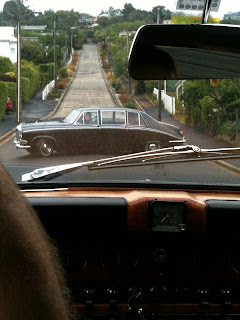
The 1971 Daimler DS420 that picked us up from the airport and drove us around Dunedin.
This car was originally brought to drive around Queen Elizabeth II when she toured New Zealand in 1977.
It was also used to drive around Nelson Mandela when he toured New Zealand in 1995.
The interior was stunning walnut.
Otago University by the river.
The staircase at the Dunedin Train Station. It has been rated in the top 10 train stations in the world due to its oppulance and incredible detail.
One of the oldest churches in Dunedin.
Outside the train station.

The Dunedin Fire Station
1967 Jaguar 420G
We used this Jaguar to tour Dunedin.
The steepest street in the world!
Dunedin Street art
The Greggs factory. Dunedin either smells of coffee (Greggs) or Chocolate (Cadbury).
The students say that some nights the factory does it herbs and spices and all the streets smell of Oregano, garlic or other Gregg products.
The University
The view from my room overlooking the new stadium and the harbour.
Some of the fellows enjoying the ride in the Daimler. Felt a bit like Royalty!



















































